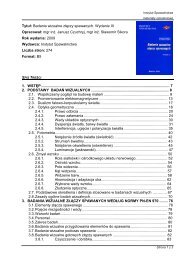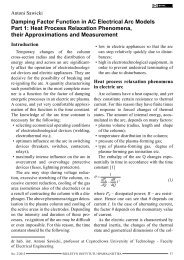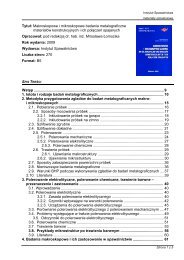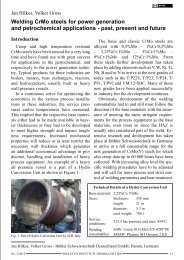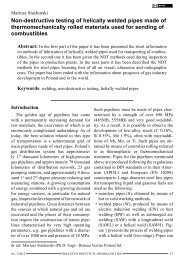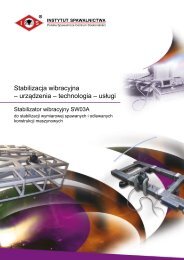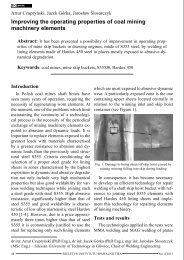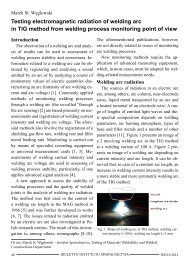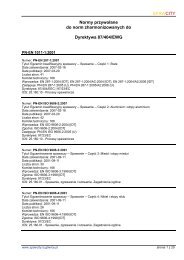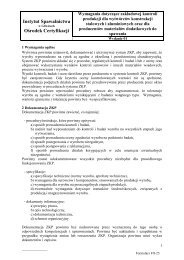Biuletyn Instytutu Spawalnictwa No. 01/2012
Biuletyn Instytutu Spawalnictwa No. 01/2012
Biuletyn Instytutu Spawalnictwa No. 01/2012
You also want an ePaper? Increase the reach of your titles
YUMPU automatically turns print PDFs into web optimized ePapers that Google loves.
case of TIG welding (for similar welding current<br />
intensity). In the same welding conditions<br />
the intensity of infrared radiation does not<br />
change significantly. During submerged arc<br />
welding visible radiation and ultraviolet radiation<br />
is absorbed by a flux layer [11].<br />
The characteristic radiation of ions and<br />
atoms in an arc is discrete; argon, iron, oxygen<br />
and nitrogen atoms and ions being the main<br />
source of radiation. The radiation intensity<br />
of other elements is significantly lower. The<br />
wavelength range of visible radiation contains<br />
mainly spectra of iron, oxygen, nitrogen and,<br />
only partially, argon (whose ionisation potential<br />
is significantly higher) [17]. The latter<br />
also means that the emission of light by argon<br />
atoms and ions occurs at higher arc temperatures<br />
than temperatures obtained during welding<br />
in e.g. Ar+CO 2<br />
mixes.<br />
Examinations of a discrete spectrum provide<br />
information about a temperature emitting<br />
particle radiation; this being due to the fact<br />
that the excitation of a particle requires a supply<br />
of specific energy, a measure of which can<br />
be temperature. The source of this type of radiation<br />
in a welding arc is mainly arc column<br />
plasma as well as metal transported by an arc,<br />
slag and the surface of elements being welded<br />
[18]. The energy of areas in the vicinity of the<br />
anode and cathode of a welding arc is used<br />
mainly for heating and melting of an electrode<br />
and base metal. It is known that the potential<br />
and kinetic energy of electrons is transformed<br />
into thermal energy on the surface of an anode<br />
and causes its intensive heating [17].<br />
The radiation of a welding arc is a complex<br />
phenomenon depending on many welding parameters.<br />
In order to be able to apply the radiation<br />
of an arc in the accurate and reliable<br />
monitoring of a welding process, one should<br />
create a model binding the intensity of welding<br />
arc visible radiation with welding parameters<br />
[19].<br />
A welding arc can be treated as a point source<br />
of radiation. Such an approach, however,<br />
appears inadequate in many applications. It<br />
seems more proper to treat an arc as a cylindrical<br />
source of radiation (Fig. 3) as such a model<br />
better reproduces the actual shape of a welding<br />
arc and facilitates accurate examination of arc<br />
radiation. For this reason, the aforesaid model<br />
will be discussed in more<br />
detail. A cylindrical model<br />
can also be simplified<br />
and a welding arc can be<br />
presented as a hemisphere.<br />
Such an approach is<br />
used in designing of systems<br />
for monitoring of<br />
automated welding processes,<br />
based on visual<br />
systems [20, 21].<br />
A welding arc column<br />
Fig. 3. Model of<br />
welding arc<br />
in TIG method [6]<br />
is composed of three types<br />
of particles: electrons,<br />
ions and neutral atoms. It<br />
is assumed that an arc column is in a state of<br />
local thermodynamic equilibrium, at which<br />
electron collisions play an important role in<br />
excitation and ionisation.<br />
Equation 2 illustrates the emission of welding<br />
arc radiation of a continuous spectrum.<br />
After taking into consideration the dependence<br />
between a wavelength and frequency<br />
c/λ=ν and the Planck function for a black<br />
body, the Rayleigh-Jeans law is satisfied when<br />
hν/kT






